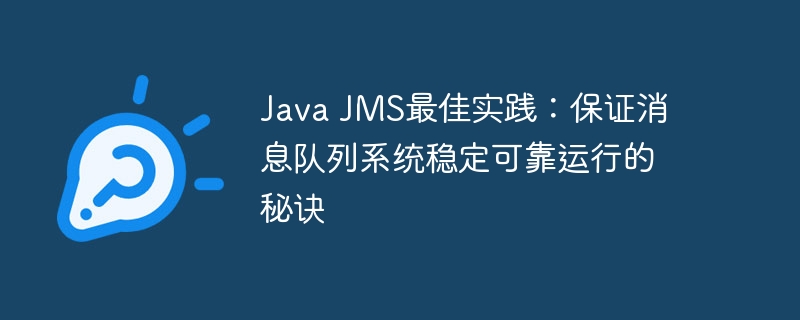
1. Select the appropriate JMS provider
As an important part of the message queue system, Java JMS plays a key role in ensuring the stable and reliable operation of the system. PHP editor Xiaoxin will reveal to you the best practices of Java JMS and the secret to ensuring the stable and reliable operation of the message queue system. Through this article, you will learn how to optimize JMS configuration, deal with message loss issues, ensure the reliability of message delivery, and how to deal with system failures and other key skills, which will help you improve the performance and stability of the message queue system in practice.
When choosing a JMS provider, you need to consider the following factors:
-
Performance: The performance of your JMS provider is the primary factor you need to consider. You need to choose a JMS provider that can meet your throughput and latency requirements.
-
Reliability: The reliability of the JMS provider is also very important. You need to choose a JMS provider that ensures messages are not lost or corrupted.
-
Scalability: The scalability of your JMS provider is also a factor you need to consider. You need to choose a JMS provider that can scale as your business grows.
-
Ease of use: The ease of use of the JMS provider is also very important. You need to choose a JMS provider that is easy to use and manage.
2. Design and build message queue
After selecting a suitable JMS provider, you can start designing and building your message queuing system.
When designing a message queue system, you need to consider the following factors:
-
Types of message queues: JMS providers generally support two types of message queues: point-to-point (PTP) queues and publish/subscribe (Pub/Sub) queues. The PTP queue is a message queue in which each message can only be consumed by one consumer. A Pub/Sub queue is a message queue where each message can be consumed by multiple consumers.
-
The structure of the message queue: You can use the JMS provider to create a simple message queue, or you can create a more complex message queue structure. For example, you can use a JMS provider to create a message queue with multiple levels, or you can use a JMS provider to create a message queue with multiple topics.
-
Security of Message Queuing: You need to ensure that your message queuing system is secure. You need to use the security features provided by your JMS provider to protect your message queuing system from unauthorized access.
3. Monitoring and managing message queue system
After deploying your message queue system, you need to monitor and manage it.
You need to monitor the following indicators:
-
Message queue throughput: You need to monitor the message queue throughput to ensure that it is meeting your needs.
-
Latency of Message Queue: You need to monitor the latency of Message Queue to ensure that it can meet your requirements.
-
Message queue errors: You need to monitor message queue errors to ensure that it is functioning properly.
You need to manage the following tasks:
-
Expansion of the message queue: You need to expand the capacity of the message queue as needed.
-
Backup of Message Queue: You need to back up the Message Queue to ensure that it can be recovered in the event of a failure.
-
Troubleshooting Message Queue: You need to troubleshoot Message Queue to ensure that it is functioning properly.
4. Demo code
The following is a code example that demonstrates how to create a message queue using a JMS provider:
import javax.jms.Connection;
import javax.jms.ConnectionFactory;
import javax.jms.Destination;
import javax.jms.MessageProducer;
import javax.jms.Session;
public class JmsProducer {
public static void main(String[] args) throws Exception {
// Create a connection factory
ConnectionFactory connectionFactory = new ActiveMQConnectionFactory("tcp://localhost:61616");
// Create a connection
Connection connection = connectionFactory.createConnection();
// Create a session
Session session = connection.createSession(false, Session.AUTO_ACKNOWLEDGE);
// Create a destination
Destination destination = session.createQueue("myQueue");
// Create a message producer
MessageProducer producer = session.createProducer(destination);
// Create a message
Message message = session.createTextMessage("Hello, world!");
// Send the message
producer.send(message);
// Close the connection
connection.close();
}
}Copy after login
5. Summary
In this article, we discussed Java JMS best practices. We discussed how to choose the right JMS provider, how to design and build a message queue, and how to monitor and manage a message queue system. We also provide a code example that demonstrates how to create a message queue using a JMS provider. Hope this article is helpful to you.
>Soft Exam Advanced Examination Preparation Skills/Past Exam Questions/Preparation Essence Materials" target="_blank">Click to download for free>>Soft Exam Advanced Exam Preparation Skills/Past Exam Questions/Exam Preparation Essence Materials
The above is the detailed content of Java JMS Best Practices: Secrets to Ensure Stable and Reliable Operation of Message Queuing Systems. For more information, please follow other related articles on the PHP Chinese website!


